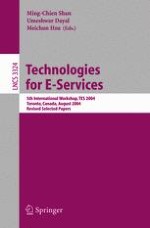The 2004 VLDB workshop on Technologies on E-Services (VLDB-TES 2004) was the ?fth workshop in a series of annual workshops endorsed by the VLDB Conference.Itservedasaforumfortheexchangeofideas,resultsandexperiences in the area of e-services and e-business. VLDB-TES 2004 took place in Toronto, Canada. It featured the presen- tion of 12 regular papers, focused on major aspects of e-business solutions. In addition, the workshop invited 2 industrial speakers to share their vision, insight and experience with the audience. The workshop would not have been a success without help from so many people. Special thanks go to Fabio Casati, who organized the program agenda and the proceedings publication, and Chandra Srivastava, who served as the publicity chair. We also thank the members of the program committee and the additional reviewers for their thorough work, which greatly contributed to the quality of the ?nal program. We hope that the participants found the workshop interesting and stimul- ing, and we thank them for attending the workshop and for contributing to the discussions.
